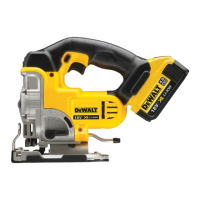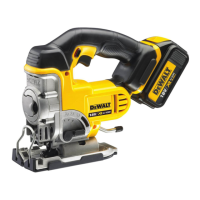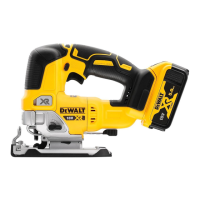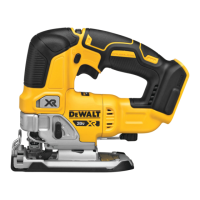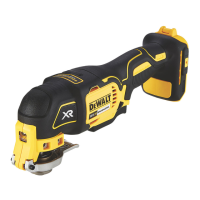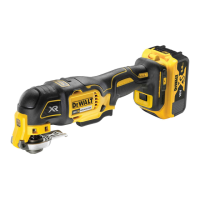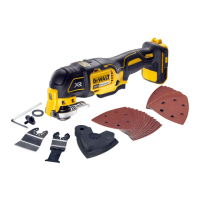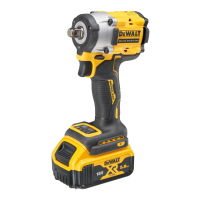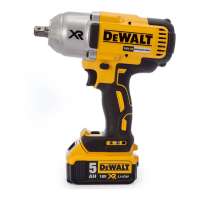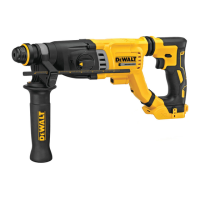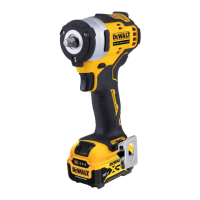13
ENGLISH
Dust Blower (Fig.G)
The dust blower
19
helps clear the cutting area of debris
created from theblade.
Dust Extraction (Fig.A, H)
WARNING: Dust can be hazardous to health. Always
work with a dust extractor. Always observe the national
regulations for work with dust emittingtools.
The dust extraction chute in combination with the dust
extraction shroud helps extract dust from the workpiece surface,
when connected to a suitable dust extractionsystem.
NOTE: The tool will not bevel if the dust extraction accessories
are attached to thetool.
1. Place the dust extraction shroud
15
onto the finger
guard
5
(Fig. A) until it clicks intoplace.
2. Slide the dust chute
16 from the back of the tool until
it snaps into the dust shroud. Be sure the adapter end is
facingup.
3. To connect a vacuum to the dust chute
16
, place a DeWALT
AirLock (DWV9000), found on all full size
DeWALT vacuum
hoses, over the dust collection port, and twist the collar
to lock it into place. The dust chute will also fit a standard
35mmconnector.
Removeable Anti-Scratch Shoe Cover (Fig.I)
The anti-scratch shoe cover
17
should be used when cutting
surfaces that scratch easily, such as laminate, veneer orpaint.
To attach anti-scratch shoe cover
17
, place the front of the
shoe
7
into the front of the anti-scratch shoe cover and lower
the jig saw. The anti-scratch shoe cover will click securely onto
the rear of theshoe.
To remove anti-scratch shoe cover, grasp the anti-scratch shoe
cover from the bottom; holding onto the two rear tabs
18
remove the anti-scratch shoecover.
Anti-Splinter Insert (Fig.I, J)
NOTE: Do not use the anti-splinter insert with the flush
cuttingbladeDT2074.
The anti-splinter insert
20
should be used when trying to
minimize tear-out, especially when cutting veneer, laminate, or
finished surfaces, such as paint. The anti-splinter insert should
be installed into the anti-scratch shoe cover
17
. If the no-mar
cover is not used, install anti-splinter insert into shoe
7
.
Setting the Electronic Sawing Speed
(Fig.A,K)
DCS334
To preset the sawing speed, turn the speed control dial
3
to the
desired level. The higher the number on the speed control dial,
the higher the sawing speed. The sawing speed varies with the
pressure exerted on the variable speed trigger
1
, but will not
exceed the speed that is set by the speed control dial
3
. The
required setting depends on the thickness and kind ofmaterial.
NOTE: Use high speeds for sawing soft materials such aswood.
DCS335
The speed control dial
3
can be used for advance setting of the
required range ofspeed.
1. Turn the electronic control dial to the required level. The
DCS335 will turn on at that speed when the on/off switch is
moved to the ON position. The required setting depends on
the thickness and kind ofmaterial.
NOTE: Use high speeds for sawing soft materials such aswood.
Worklights
The worklights are located on either side of the blade. To turn
on the worklight, depress the trigger (DCS334) or switch on the
on/off switch (DCS335). Worklights will remain on 20 seconds
after the tool is turned on, or as long as your cut lasts.
NOTE: The worklights are for lighting the immediate work
surface and are not intended to be used as aflashlight.
Prior to Operation
Make sure your battery pack is (fully)charged.
OPERATION
Instructions for Use
WARNING: Always observe the safety instructions and
applicableregulations.
WARNING: To reduce the risk of serious personal
injury, depress the trigger lock button and
disconnect battery pack before making any
adjustments or removing/installing attachments or
accessories. An accidental start-up can causeinjury.
WARNING: Always wear proper personal hearing
protection. Under some conditions and duration of use,
noise from this product may contribute to hearingloss.
WARNING: Risk of dust inhalation. To reduce the risk of
personal injury, ALWAYS wear an approved dustmask.
WARNING:
• Make sure your workpiece is well secured. Remove
nails, screws and other fasteners that may damage
theblade.
• Check that there is sufficient space for the blade
underneath the workpiece. Do not cut materials that
are thicker than the maximum cuttingdepth.
• Use sharp saw blades only. Damaged or bent saw
blades must be removedimmediately.
• Never run your tool without a sawblade.
• For optimal results, move the tool smoothly and
constantly over the workpiece. Do not exert lateral
pressure on the saw blade. Keep the shoe flat on the
workpiece. When sawing curves, circles or other round
shapes, push the tool gentlyforward.
• Wait until the tool has come to a standstill before
removing the saw blade from the workpiece. After
sawing the blade may be very hot. Do nottouch.
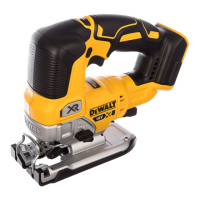
